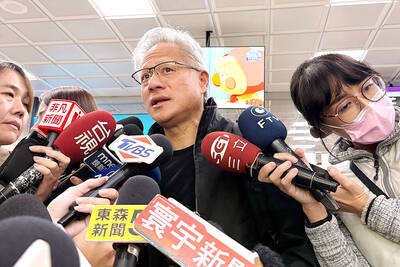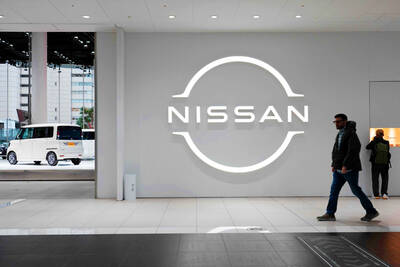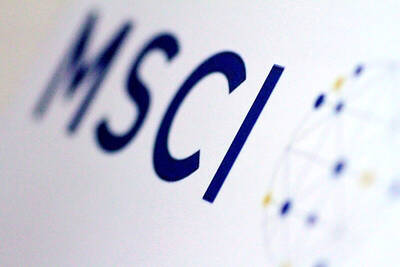Outdone by a tower extending to more than 800m high in Dubai, the world’s former tallest building, Taipei 101, wants to become the tallest “green” skyscraper by completing a checklist of clean energy standards, a spokesman said yesterday.
Taipei 101 will spend NT$60 million (US$1.9 million) over the next year to meet 100 criteria for an environmental certificate that it would hold over Dubai, spokesman Michael Liu (劉家豪) said.
The office-commercial tower that reigned for five years as the world’s highest building at 509m expects the US-based Leadership in Energy and Environmental Design to give it the certificate next year.
“We’re focused now on becoming a Taiwan landmark, that won’t change, and on going green. We’d be the tallest building to get a green certificate,” Liu said by telephone.
Taipei 101, he said, would work with its 85 office tenants to cut electricity and water use, while encouraging them to recycle more refuse. Annual utility savings should total NT$20 million.
Restaurants would be asked to bring in supplies from as close as possible to reduce transportation.
“We can reduce power, trash and water by more than 10 percent,” he said. “We’re already pretty green. In principle, there’s no major problem.”
The skyscraper, complete with an observation deck popular with tourists, has already met 60 of the checklist items, including double-paned windows to retain cool air.
Green towers are unusual in Asia, a region with the world’s busiest construction sector yet one of the poorest records for eco-friendly buildings.
Burj Dubai, started at the height of the economic boom and built by some 12,000 laborers, will now become the world’s tallest building. It was set to open yesterday as Dubai seeks to rekindle optimism after its financial crisis.

PERSISTENT RUMORS: Nvidia’s CEO said the firm is not in talks to sell AI chips to China, but he would welcome a change in US policy barring the activity Nvidia Corp CEO Jensen Huang (黃仁勳) said his company is not in discussions to sell its Blackwell artificial intelligence (AI) chips to Chinese firms, waving off speculation it is trying to engineer a return to the world’s largest semiconductor market. Huang, who arrived in Taiwan yesterday ahead of meetings with longtime partner Taiwan Semiconductor Manufacturing Co (TSMC, 台積電), took the opportunity to clarify recent comments about the US-China AI race. The Nvidia head caused a stir in an interview this week with the Financial Times, in which he was quoted as saying “China will win” the AI race. Huang yesterday said

Nissan Motor Co has agreed to sell its global headquarters in Yokohama for ¥97 billion (US$630 million) to a group sponsored by Taiwanese autoparts maker Minth Group (敏實集團), as the struggling automaker seeks to shore up its financial position. The acquisition is led by a special purchase company managed by KJR Management Ltd, a Japanese real-estate unit of private equity giant KKR & Co, people familiar with the matter said. KJR said it would act as asset manager together with Mizuho Real Estate Management Co. Nissan is undergoing a broad cost-cutting campaign by eliminating jobs and shuttering plants as it grapples

The Chinese government has issued guidance requiring new data center projects that have received any state funds to only use domestically made artificial intelligence (AI) chips, two sources familiar with the matter told Reuters. In recent weeks, Chinese regulatory authorities have ordered such data centers that are less than 30 percent complete to remove all installed foreign chips, or cancel plans to purchase them, while projects in a more advanced stage would be decided on a case-by-case basis, the sources said. The move could represent one of China’s most aggressive steps yet to eliminate foreign technology from its critical infrastructure amid a

MORE WEIGHT: The national weighting was raised in one index while holding steady in two others, while several companies rose or fell in prominence MSCI Inc, a global index provider, has raised Taiwan’s weighting in one of its major indices and left the country’s weighting unchanged in two other indices after a regular index review. In a statement released on Thursday, MSCI said it has upgraded Taiwan’s weighting in the MSCI All-Country World Index by 0.02 percentage points to 2.25 percent, while maintaining the weighting in the MSCI Emerging Markets Index, the most closely watched by foreign institutional investors, at 20.46 percent. Additionally, the index provider has left Taiwan’s weighting in the MSCI All-Country Asia ex-Japan Index unchanged at 23.15 percent. The latest index adjustments are to